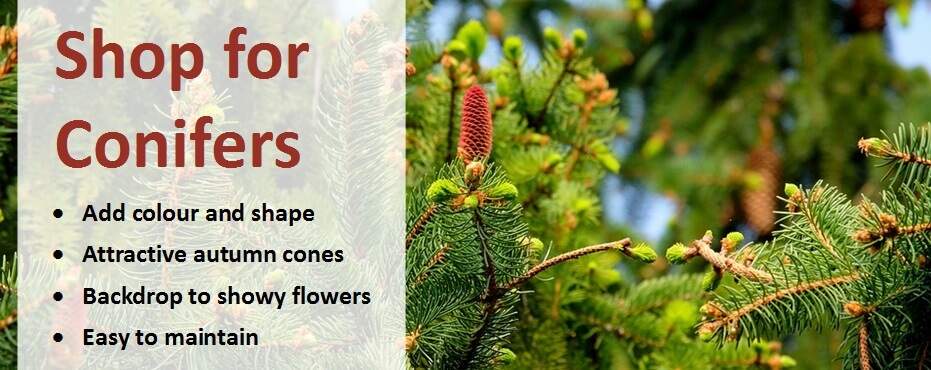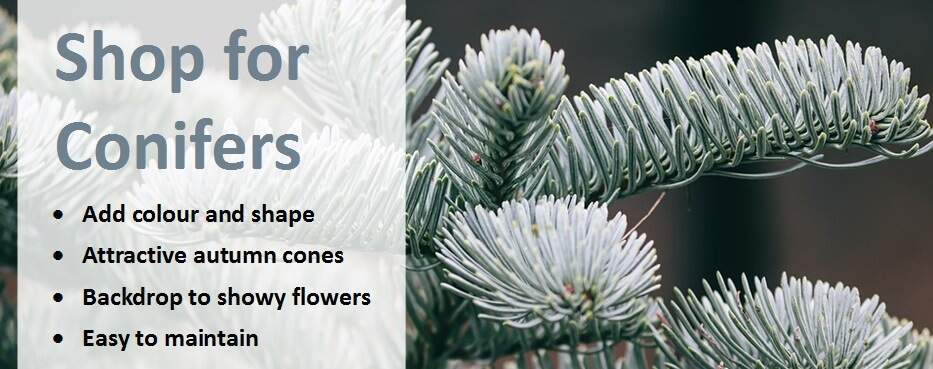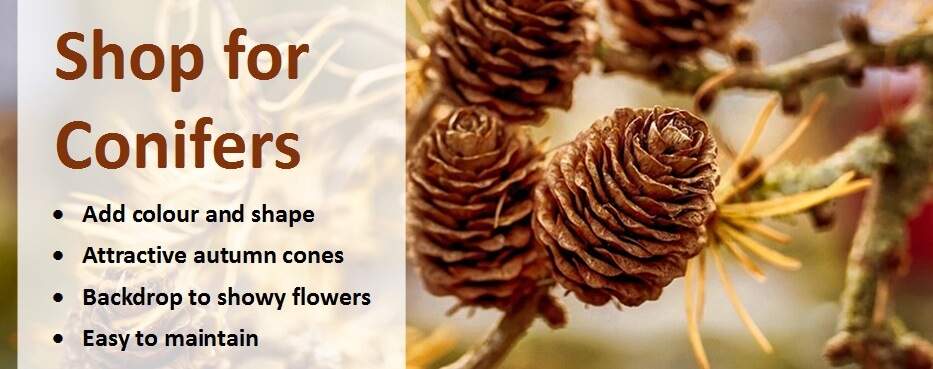Guide to Conifers
Whilst conifers are traditionally thought of as conical evergreen trees with a single, straight trunk and side branches, they actually come in a huge range of shapes and sizes, ranging from large trees to small prostrate ground cover plants. The name 'conifer' comes from Latin and means 'cone bearing'. Dating back 290 million years, all conifers bear their seeds in separate cones, rather than in flowers, which can be either woody or fleshy with trees usually bearing both male and female cones. Male cones produce pollen grains which wind pollinate the female cones. The foliage of conifers is either short, spiky and needle-like (such as Spruce and Pine trees) or scale-like (such as Cupressus and Chamaecyparis), often spirally arranged, held in whorls of 3-4 or in opposite pairs. Colours range from golds and yellows, various shades of blue-green to purplish brown, often varying according to the season.
Many conifers have a narrow, conical shape and drooping downward limbs, traditionally a winter-time adaptation to help them shed snow. Forms vary from columnar and fastigate to dome-shaped, low-growing and even weeping, always with a shallow, fibrous and spreading root system. Conifers are also famed for their distinctly scented resin which is secreted from the trunk and branches to protect the tree against attack by insects and avoid fungal infection of wounds. There are extensive forests of conifer trees in Canada, Scandanavia and Siberia, northern parts of America and Eurasia, where they are economically important as a source of timber and paper production. In the garden, conifers are a favourite of landscapers and gardeners alike due to the huge range of varieties that are available for ornamental purposes. When used effectively, they can provide an excellent range of design solutions for the innovative gardener, extending well beyond their traditional uses as rockery plants and hedging plants.
Uses of Conifers
Conifers are highly adaptable, usually grown for the colour, texture and structural diversity they bring to the garden throughout the year. Foliage comes in a wide range of colours and there is a conifer for just about every situation in the garden. They are invaluable in that they provide year-round ornamental value, in contrast to many deciduous shrubs which only provide interest for a limited part of the year. Conifers are tolerant of a wide range of conditions, demonstrated by the way they occupy almost all major landscapes from the dark forests of the west coast of Alaska to the centre of the Sahara; the Arctic to the Equator; and lowland savannas by the sea to near the perpetual snow line of the highest mountains.
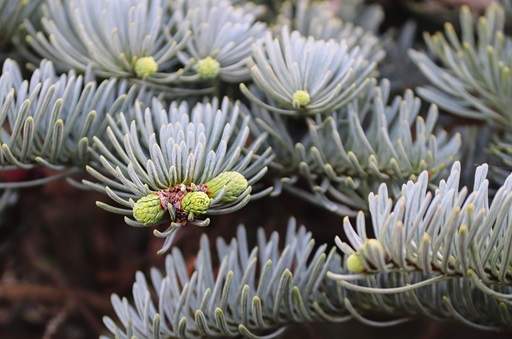
Whilst conifers are highly versatile plants, their traditional use as a dense, evergreen hedge should not be forgotten. Mainly growing as dense trees, conifers make a fantastic perimeter barrier and privacy screen for your home, acting as a visual obstacle and windbreak, reducing noise, providing shelter for animals and keeping out nosey neighbours all at the same time. Green Leylandii and gold Leylandii are popular for their rapid growth, best maintained with regular, light trimming to ensure the health of the plants is not affected.
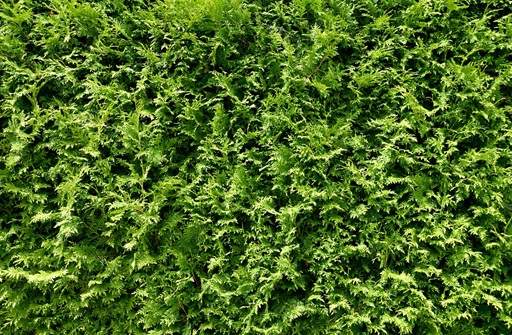
Taxus baccata plants (yew hedging), with their highly ornate, red fleshy cones, are one of the very few conifer varieties that will re-grow from old wood, making them suitable for hard pruning. Thuja Golden Globe should also not be dismissed as a slower and lower-growing golden variety which is excellent for delineating different parts of the garden. Be careful with planting distances as many conifers have a tendency to drop their lower branches if planted too close together, which makes them ineffective as a windbreak as the wind gets funnelled beneath the plants near ground level.
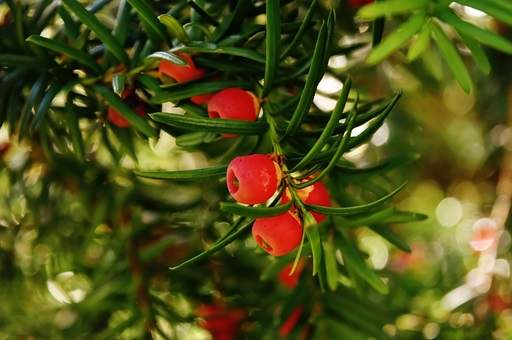
Dwarf conifers are a favourite for the rock garden because they stand up to the rigours of the British winter to shine through all of the seasons, providing colour, interest, form and texture. Dwarf conifers are really 'witch's brooms' - a deformity of part of a conventional, conically shaped conifer which results in the natural structure of the plant being changed. These low, congested or weeping growths are then grafted onto a rootstock as a means of propagation and, if proven worthy, used as smaller garden plants for the fronts of borders and rockeries. Dwarf conifers are the staple of rock gardens because they can be used to fill in the gaps between craggy rocks without dominating the beautiful rock formations. Rock gardens can be constructed using existing stone in your garden, or carefully selected hand-picked purchased material to create a stunning alpine setting.
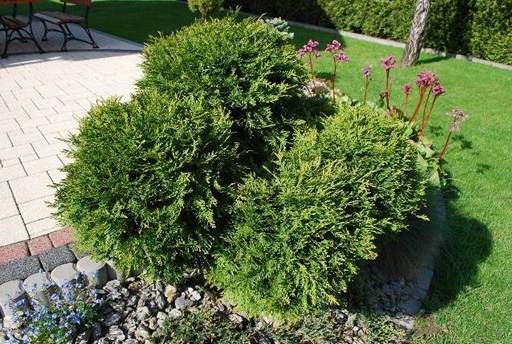
A selection of dwarf conifers grown in the rock garden
Tall, narrow varieties such as Juniper Skyrocket or Juniper Blue Arrow are excellent for adding ascent and architectural flare to the garden, best used in containers, as centre-piece plants or in structured rows. Conifers can be incorporated effectively in informal or native bush gardens; Cupressus in particular can be used to provide a stark contrast to the serene and ordered nature of a Japanese symbolic style garden and Ginkgo Biloba (Maidenhair Tree) has long, fan-shaped, bright green leaves widely considered to have health benefits, such as aiding circulation and improving cognitive function (although we recommend you do not try to treat the leaves of your own plants for consumption). Dwarf and ground cover varieties can be used in low borders, along a pathway, cascaded down a slope/over a wall, or to delineate a garden bed, whilst blue-foliage varieties such as Cedrus Glauca, Cedrus Feelin Blue and Chamaecyparis Boulevard make great contrast plants as part of shrubbery. If building a conifer bed or combining conifers with other shrubs and trees in the border, one useful trick is to use a variety of conifers with different shapes and foliage colours so that they contrast against each other. Some conifers are used as topiary plants, whilst others such as Monkey Puzzle trees are stately, architectural plants in their own right and Blue spruce is a popular Christmas tree.
Garden Care
Planting
Conifers prefer a rich loamy soil, high in organic content, preferably acidic and moist, but reasonably well drained (conifers do not like standing with wet feet, even if only for a short time). If you want to grow conifers but have a very heavy, clay soil which puddles easily, consider constructing a raised bed to improve drainage. You may wish to make this a raised rockery so your conifer's roots can stay cool and moist under the stone. Adding lime also helps to raise the soils pH (making it more alkaline). If growing as standalone plants, dig a planting hole twice the width and 1.5 times the depth of the rootball, build in multi-purpose compost or organic matter and loosen up the bottom of the hole by gently spiking with a garden fork to encourage the downward growth of roots. Backfill before re-securing the ground firmly with your boot.
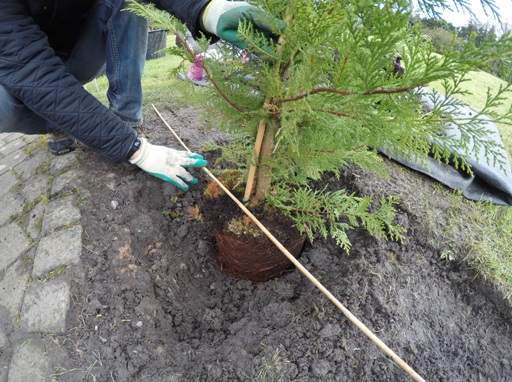
To plant a conifer hedge, dig a trench 50cm (20 inches) wide and again to a depth 1.5 times that of the root balls. Plant between 60cm (24 inches) and 90cm (36 inches) apart depending on how dense a screen you're looking to achieve and whether you're prepared to wait for the plants to fill out, or want something more instant. Use a planting line to ensure you don't end up with a wavy row and backfill with a mix of the topsoil and multi-purpose compost.
Watering and Weeding
Water thoroughly after planting and during establishment to ensure there is sufficient moisture for the roots to take hold. Even once established, watering is strongly recommended during prolonged periods of dry weather, particularly as conifers have shallow, fibrous roots so are not able to access deeper water stores that other plants such as rose bushes with long, tap roots would be able to reach. Always water your conifers from underneath, being careful not to get the lower leaves wet because direct sunlight can result in the burning of wet foliage, which may lead to unsightly brown patches that are difficult to rectify. Remove competing vegetation within 30cm (1 foot) each side of your plants and mulch regularly to reduce the likelihood of further weeds developing.
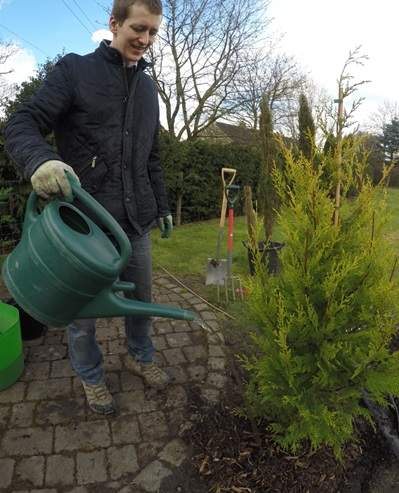
Feeding and Mulching
Conifers are not demanding or greedy plants, so an annual feed with a general purpose fertiliser at the end of each winter is usually sufficient. However, it is important to keep the roots cool and dry and not allow your plants to dry out. Soils around conifers can be rapidly depleted of nutrients and moisture, making it difficult for other plants to grow beneath a conifer's canopy and leaving your conifers themselves in need of replenishment. Additionally, the foliage of many conifers contains toxins which impair the growth of other plants underneath them. To combat this issue, we recommend mulching the base of your conifers generously with a thick layer (8cm / 3 inches) of well-rotted organic matter such as lawn clippings, leaf mound, straw or garden compost. This will help to retain moisture and keep the soil temperature cool. Leave a ring between the trunk and the mulch to avoid infection.
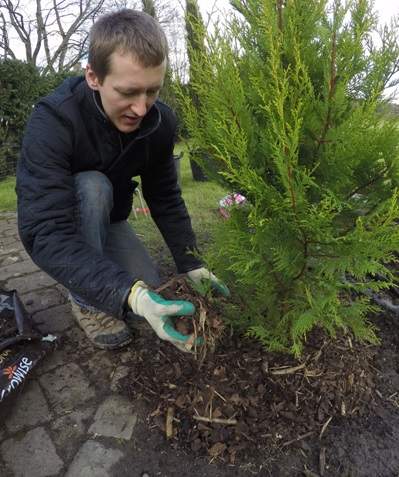
Pruning and Brown Patches
Conifers should be trimmed using hedge shears in spring or during a cooler period in early summer. In fact, pruning during dark and rainy weather is best because trimmers work more effectively on wet foliage due to the benefit of water lubrication and it means your foliage won't get scorched. Do not trim in the summer during times of plant stress, such as prolonged drought or hot, dry spells. Most conifers have little or no capacity to re-grow from old wood once it has been pruned into (with the notable exception of yew plants), so over-enthusiastic hedge trimming is discouraged as it often results in bare patches. Instead, trim little and often in April, June and early August, being careful to ensure you do not cut into brown, woody, older stems.
Brown patches are often found at the base of a hedge, but can develop at any height. The main causes are adverse growing conditions such as drought, frost, water-logging, cold, drying winds or over-zealous pruning, all of which inhibit regeneration from the trimmed foliage. Ensuring conifers are sited in a suitable location and, more importantly, that soil is prepared and maintained accordingly (as above) is key. Cypress aphids are another common culprit which eat into fresh green foliage and can spread rapidly if not spotted and addressed early on. If aphids are identified, spray with an insecticide such as bug killer spray as soon as signs of damage are seen. Fungal growth is another potential cause of brown patches, particularly right at the base of the plant. This is again typically linked to your soil and planting site, but ensuring that a gap is maintained between the trunk of your conifers and any mulch that is applied is also key.
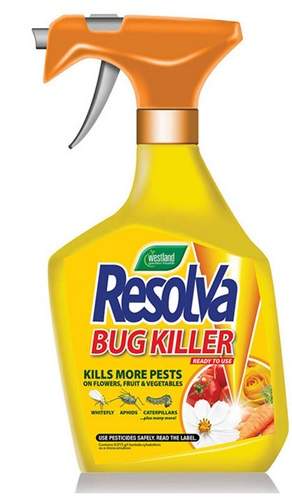
Spray aphids with a bug killer spray
-
Plant Guides
- Guide to Bamboo Plants
- Guide to Climbing Plants
- Guide to Climbing Roses
- Guide to Conifers
- Guide to Floribunda Roses
- Guide to Fruit Bushes
- Guide to Fruit Trees
- Guide to Garden Ferns
- Guide to Garden Shrubs
- Guide to Heather Plants
- Guide to Hedging Plants
- Guide to Herb Plants
- Guide to Herbaceous Perennials
- Guide to Hybrid Tea Roses
- Guide to Japanese Maple Trees
- Guide to Ornamental Grasses
- Guide to Rhododendrons
- Guide to Topiary
Share this page:

